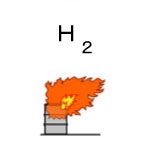| Case Name |
Leakage and fire of gas from a high-temperature heat exchanger at a benzene manufacturing plant using a dealkylation reaction |
| Pictograph |

|
| Date |
September 20, 1998 |
| Place |
Kamisu, Ibaragi, Japan |
| Location |
Chemical factory |
| Overview |
During start-up operation of a high-temperature and high-pressure plant using hydrogen, gas leaked from the flange of the heat exchanger and a fire occurred. The leakage occurred for two reasons: 1) insufficient tightening torque control was carried out during hot-bolting and unbalanced force among the bolts was generated. 2) A temperature rise of the heat exchanger as a result of revamping during a turnaround shutdown. |
| Incident |
During warm-up operation on starting up a benzene manufacturing plant using hydrogen at a high temperature and pressure, hydrogen gas leaked through the heat exchanger flange, and a fire occurred. At the plant, benzene was produced by a dealkylation reaction using toluene and C9 aromatic hydrocarbon as raw material. |
| Processing |
Manufacture |
| Individual Process |
Maintenance |
| Chemical Equation |
Fig2.Chemical reaction formula
|
| Substance |
Hydrogen, Fig3 |
| Methane, Fig4 |
| Type of Accident |
Leakage, fire |
| Sequence |
1. A turnaround shutdown of the benzene manufacturing plant was carried out in June.
2. A gas-tightness test with real gas (hydrogen and another gas) was completed in September, and raising temperature and pressure work of the plant started.
3. During the operation, an operator at an adjoining plant found a fire at the upper part of the vertical reactor. |
| Cause |
1. There was unbalanced tightening torque among bolts of the flange.
2. The shell-side inlet temperature rose from the previous 400 °C to 420 °C as a result of the energy-saving revamping.
3. A decrease in tightening torque was locally generated by a difference in thermal expansion between bolts made of stainless steel and the flange made of carbon steel. Thermal expansion of stainless steel is greater than that of carbon steel.
4. The ignition source was considered to be static electricity generated at leakage. |
| Response |
An emergency shutdown was performed. Nitrogen purging of relevant equipment was conducted. |
| Countermeasures |
1. Quantitative control of initial axial force is strengthened on tightening bolts.
2. Establishment of field patrol and strengthening of monitoring during a temperature rise. |
| Knowledge Comment |
1. Quantitative control of tightening torque should be executed at a high-temperature and high-pressure plant.
2. Insufficient study not only on chemical affects of a temperature rise but also on mechanical aspects, when the temperature of equipment rises during energy-saving revamping, etc. |
| Background |
1. Quantitative control of tightening torque of the bolt was insufficient, and there was a local shortage of initial tightening torque.
2. It is speculated that there might be an insufficient work standard ofr hot-bolting or imperfect execution of hot-bolting.
3. The temperature rose as a result of energy-saving revamping, and the effects might have been overlooked.
Hot-bolting: In equipment and piping that operate at a high temperature, as the temperature rises, the tightening force decreases, so re-tightening of bolts is necessary. This work is called hot-bolting. The design conditions of the evaporator where the fire occurred were 2.4 MPaG, 3.9 k and 500 °C at the shell side, and 2.8 MpaG, 300 °C at the tube side, and it required hot-bolting. |
| Reason for Adding to DB |
Example of leakage and fire caused due to a loosening flange during temperature rising operation in a high temperature reactor |
| Scenario |
| Primary Scenario
|
Poor Value Perception, Poor Safety Awareness, Inadequate Risk Recognition, Organizational Problems, Poor Management, Slackness of Management, Misjudgment, Misunderstanding, Poor Detail Planning, De-alkylation Reaction, Planning and Design, Poor Planning, Poor Planning of Repair, Usage, Maintenance/Repair, Repair, Malfunction, Poor Hardware, Wrong Tightening, Secondary Damage, External Damage, Explosion
|
|
| Sources |
Fire and Disaster Management Agency. Second benzene plant. MHC feed evaporator (2E-614) fire. Accident cases of dangerous materials. 1998. pp.46-47.
High Pressure Gas Safety Inst. of Japan. High-pressure gas protection overview. 1999 edition. p.72(2000)
|
| Physical Damage |
About 4.9 square meters of the top of a feed evaporator of a reactor burned. |
| Financial Cost |
¥ 300,000. (Fire and Disaster Management Agency) |
| Multimedia Files |
Fig3.Chemical formula
|
|
Fig4.Chemical formula
|
| Field |
Chemicals and Plants
|
| Author |
KOBAYASHI, Mitsuo (Office K)
TAMURA, Masamitsu (Center for Risk Management and Safety Sciences, Yokohama National University)
|
|